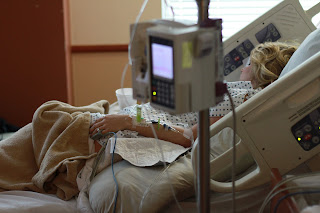Like many other financial bloggers I'm taking time now to look at the past year and see how we have done money-wise. Here is our story:
Overview of the Year:
In April I received the bulk of my inheritance (I had gotten a nice chunk in 2014, which I put into my 401K). We kept about $20,000 of my inheritance in our savings account and disbursed most of the rest of it to various investments. We also spent a little over $20,000 of it renovating our bathrooms. Unplanned expenses in 2015 included a new refrigerator (about $900) and a new dishwasher (about $500 and we hate it). Our vacation this year was a week at a friend's beach house, so while we ate out and went places, we didn't spend much on lodging. My pay has been flat; my husband's is up a couple of thousand dollars. We were able to meet current expenses out of our checkbook except for tuition/room/board for my girls. Those bills total about $10,000 a year and we had to pull about $5,000 from our savings to pay for it.
On the savings front, besides what we did with my inheritance, we were able to save about 11% of my pay and about 5% of my husband's pay (we make about the same) in our 401Ks. My firm gives me 5% of my salary in my husband gets 3% of his pay, so about 12% of our combined pay ended up in our 401Ks.
Investments and Results:
Lending Club: We earned $1603.61 from Lending Club this year. Here are some charts that show how I am doing, at least with the notes I purchased new on the platform. However, I also purchased a bunch of resale notes, hoping they would be safer, less likely to default. I was wrong and won't be doing that anymore.
You can click on the photos to see them better, but the chart above shows that without adjusting the value of the account for notes that are currently late, but which have not defaulted, I have an annualized return of 12.68%, and that the weighted average interest rate on the notes in my portfolio is 16% The bright blue dot is me; the red dots are people with portfolios like mine and the blue dots are other Lending Club investors. You can see I'm in the middle of the pack; not the best, not the worst. You can also see that it is likely that as my portfolio ages, my returns will fall.
This chart is adjusted for past due notes. It shows me doing somewhat better as compared to my peers and it shows that the big decrease in value has likely already happened, though again, as the portfolio ages, I can expect further drops. This chart shows my likely annualized return on those notes to be 9.39%.
Prosper: All the notes in this portfolio were purchased new. Prosper shows values a little differently than Lending Club does. Instead of using averages to estimate returns like Lending Club does, Prosper shows "Seasoned" returns--returns on notes that are at least ten months old, since they have found that returns stabilize about that time. Here are my Prosper stats:
You can see that on my overall portfolio, I am averaging 13.21%. This is less than on my seasoned notes because my first notes were higher risk notes; my last big infusion of cash was almost all in A and B notes and it was in March, less than ten months ago.
On the left you can see the breakdown of my Prosper account across note grades. You can also see my seasoned return. This year I made $1,621.41 from Prosper.
Motif: Over the course of the year I invested $7,000 in eight different "Motifs" or groups of stocks. I collected $74.09 in dividends and as of 12/31 the account was worth $7,104.29. so I gained a little too. If you want to look them up, the Motifs in which I have invested are "Things I Like", "Low Beta", "Growing Dividends", "High-Yield Dividends", "Buyback Leaders", "Cyber Security" "Online Gaming World" and "Online Video". My winners are "Growing Dividends" which is up 2.5% since I bought it, compared to the S&P 500, which is up 1.6% in that time; and "Online Gaming World" which is up 23.7% since I bought it, as opposed to the S&P, which is down 3.3% in that time.
If you'd like to try your hand with Motif,
use this link. If you invest $1,000, we both get $100.
HD Vest into Vanguard: This is the money we had invested with a financial adviser. It consisted of three accounts: my IRA, my husband's IRA and a taxable account. At one point late in 2015, all our investments were in the black, except these accounts. They threw off earnings every month but then every three months most of those earnings would be eaten up by fees. We decided to take our money over to Vanguard, and in doing so, learned of yet more fees--HD Vest wanted $95.00 per account to terminate the accounts and transfer the securities. Once we got the money over to Vanguard, we wanted to sell the funds HD Vest put us in as they had us in about twenty different mutual funds and keeping up with them was just more work than I wanted. We learned that it was going to cost us $20 per fund per account to sell them all (and it would have cost the same had we sold them before the transfer). We decided to keep those funds that were meeting or beating their benchmarks and to funnel our dividends and capital gains into Vanguard index funds. We'll keep watching the others, but I hate to spend $20 to sell $1000 worth of an adequate mutual fund. All in all, our foray with HD Vest and our financial adviser proved to be very expensive. This year our total fees on these three accounts were $3851.56. Our total loss was $12, 565.71.
Roth IRAs invested in Vanguard's S&P 500 Index fund: Both my husband and I have Roth IRAs with Vanguard. We deposited $14,000 into these accounts over the course of the year. The accounts paid $1176.50 in dividends and capital gains, but over the course of the year lost $634.49.
My 401K: This is invested 75% in stock mutual funds and 25% in a bond fund. I re-balance monthly and invest 8% of my pay, and my company kicks in 5%. For the first half of the year I invested more. This account actually gained 0.42%. Capital gains and dividends were $15,737.16 and fees were $6.16.
My husband's 401K: This is invested in a couple of AXA annuity funds whose ticker symbols don't work online. Like everyone else, he lost money this year, about 5%.
Loyal 3: This is my "Loyal3 Lunch" portofolio. As of 12/31 it was worth $152.07, meaning it had lost $2.93.
Kickfurther: I've invested $2686.09 and I've earned $70. I have three offers which have paid either nothing or close to it and one that has paid half and really doesn't seem capable of paying more. Kickfurther's agreements with vendors say that if the vendor is unable to sell the merchandise, they are not obligated to repay investors; instead Kickfurther repossesses the merchandise and attempts to sell it to make investors whole. Because Kickfurther is a new platform, they have just gotten to the point that they are repossessing products. So far, Kickfurther has offered by buy out all the deals that have gone bad. I've taken them up on it, so while I haven't gained anything on those deals, I haven't lost either. I'm sure that it won't be long before investors have to bear their own losses, but for now, I've gotten to keep my profits and give away my losses. Annualized, my returns are over 30%.
The Bottom Line:
I'm not going to share all my numbers with you for privacy reasons. However, I will tell you that all totaled, our investments lost $7,188 last year.
Total investment fees: $5023.30
Takeaway:
Think twice, or three times before hiring a financial adviser on an "Assets Under Management" scheme. If you don't want to watch your investments and re-adjust them for market conditions, aging etc., invest in a Target Date fund and call it good. We wouldn't have gotten rich this year in any case, but adding another $5,000 to our income sure wouldn't have hurt.































